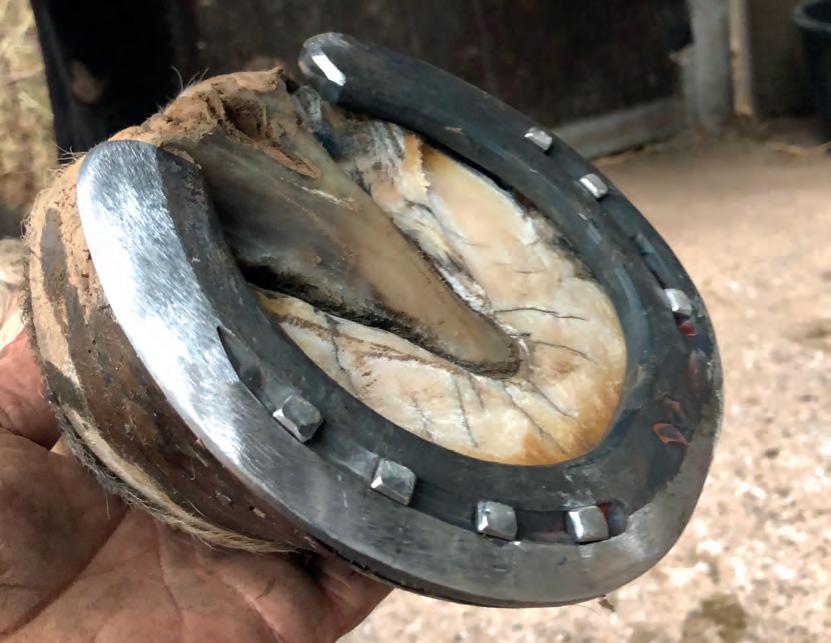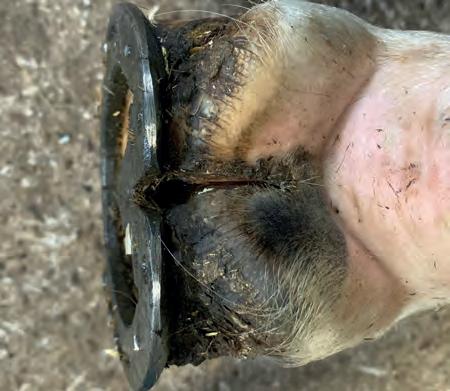
6 minute read
Feet first
We’re all familiar with the saying ‘no foot, no horse’ so how can we ensure our dressage horses’ feet are being well-maintained for soundness and longevity?
Stephanie Bateman speaks to Team GB farrier Andrew Bowyer to find out.
From ensuring the correct hoof balance to maintaining an appropriate diet and management routine for optimal hoof health, there’s a lot to consider when caring for our dressage horses’ feet.
QWhat are the common hoof shapes and potential weaknesses of a typical dressage horse?
You get a lot of warmblood types in dressage which tend to be heavier in build, which can create more stress on the hoof capsule and internal structures. Warmblood feet tend to be upright in shape, which creates various issues such as an inability to absorb and disperse concussive forces, which can in turn create pathological changes within the foot and lower limb. The heel area can also become contracted and very deep causing the frog to retract, which is then hard to keep clean.
With many dressage horses being kept stabled a lot, especially during the winter months, high levels of bacteria can cause thrush and white line disease. Once it gets deep into the central cleft of the frog it can cause the bulbs of the heels to sheer which can get really sore and hard to treat. It is important for us to keep the frogs and solar surface well-trimmed so the air can reach the area. A clean dry stable environment is also important. Hypozin, which your farrier can get, is a good product to treat thrush and sore heels to dry the area out.
QWhat are the most common issues you see in dressage horses’ feet?
Problems with foot balance and hoof cracks due to conformation. If a horse has a conformational deviation, it means that the hoof capsule will adapt to compensate, and this can result in medial lateral imbalance, anterior palmar deviation and tight upright feet which are more prone to quarter cracks. This is because there isn’t enough space within the hoof capsule for the lateral cartilage, when deformation of the hoof
PICTURED capsule is taking place during locomotion, the cartilage is pushing on the coronary band. It is quite common for dressage horses with an upright hoof conformation to blow and burst quarter cracks.
Left: Dressage poses specific challenges for hoof care, both from the typical dressage breeds’ hoof conformation and from the surfaces used for training and competition.
Right: An omnidirectional shoe can help with previous injuries or limb deviations.

QWhat is your advice for owners?
We like to work holistically with the vet, physio and horse owner so that if there is an issue, we can put a shoeing plan together. It’s the owner’s job to pull us together so we can share information and offer as much as we can for the horse and rider.
All horses have movements that they are better at and some they find hard and what we are all guilty of is practicing things they are not good at a lot so we start creating issues by repetitive forces going through the limb. There could be a good reason why they’re not able to perform that movement, whether they’re not strong enough or their shoe placement isn’t quite right and they can’t support themselves in the movement. This is when you need a holistic approach to these movements rather than practicing this movement again and again and again. You often find they get sorer and sorer.
It’s healthy for horses to hack out as well as go in the arena as it gets the blood moving around the limb and hoof, and is good for allround well-being.
QHow do arena surfaces impact a dressage horse’s feet?
Most modern surfaces are really good but it’s how the owner or yard maintains the surface which is really important because horses can get injuries from an inconsistent surface. Deep surfaces can cause abrasion, especially if you have a horse with a low arc of flight in the hindlimb due to a hock injury – they drag their hoof through the surface which can be abrasive to the hoof wall.
Keeping surfaces consistent with regular watering in the summer and harrowing is really important.
QHow can you shoe to support a dressage horse?
Dressage training works to lift horses off their forehand and place all the weight on the hindquarters, so it’s the suspensory apparatus behind and the hocks that take all the weight. Ensuring the foot balance is correct allows it to support the suspensory apparatus.
It starts with looking at the horse dynamically and how they move so you can assess any limb deviations. You should never just pull a horse out of the stable and shoe it for how it stands in front of you.
The next key thing is the trim. We make sure we trim balanced and level to the limb. I see a lot of negative palmar processes in the hind feet because the horse is always sitting on its hocks and the fetlocks are overworked so they get low in the heel and grow more toe – it’s important that we trim enough toe off to rebalance the foot for the next shoeing cycle.
The type of shoe we select is also important – if you have a client with a really deep, soft surface, we might need to put a wide shoe on to keep the horse on top of the surface so the stifles and hocks aren’t working really hard to pull the hoof out. For a consistent, firm surface you might have narrower shoes.
Then it’s shoe placement, so placing the shoe under the limb for support and width where the support is needed.
QShod or barefoot?
It depends on the individual horse and the client and environment. At the Tokyo Olympics, they didn’t have to walk on anything other than rubber matting or an arena surface, whereas in this country, horse’s feet are exposed to a multitude of substrates and environmental conditions. Shoes are definitely an advantage where you can’t control what the horse walks or competes on. Otherwise the choice of whether to shoe is dependent on the horse’s foot and limb conformation. do dressage movements impact horses’ feet?
Some people start horses off barefoot because they have good quality feet, and it’s only when they start teaching them more complex movements where they have to support themselves on one limb or lateral movements that shoes really give a performance advantage and increase the longevity of the horse. Shoes also give us the ability to place the platform where it is needed and increase the footprint of the horse.
There are also benefits of not having shoes on and in some cases, the best option is to remove the shoe and turn the horse out to start again with a blank canvas. Bacteria can also gather under a shoe and create poor horn quality and thrush.

QHow
Surfaces are really grippy which is why we will use a wide, flat shoe to encourage a certain amount of slide reducing concussive forces going through the limb.
In horses that are worked on tight circles and perform lateral work, there is an element of medial lateral torque on the joints, ligaments and tendons. If you’ve got a horse with a preexisting injury or a limb deviation you might want to fit an omnidirectional shoe (with edges taken off it) so when they are doing circles or bends there is less medial lateral torque on the coffin joint and ligaments and tendons. This means it doesn’t take much force for the horse to break over and go into the flight pattern.
QWhat supplements and hoof dressings should I use?
Nothing can substitute a good balanced diet. Dressage horses are often fed a lot of nutrients for condition and muscle development, so they lay down a lot of hoof growth which is why it’s important they are kept on a shorter shoeing cycle so we’re able to maintain good foot balance, particularly in the summer months: we recommend 4-5 weeks. It can also be dependent on the breed. Thoroughbreds generally don’t lay down as much horn whereas breeds like warmbloods will produce more.
There are some cases where horses produce poor quality horn due to a lack of a nutrient. Vitamin E is a keratin-building ingredient, and a certain amount of biotin, zinc and copper are needed for good hoof health. Zinc deficiency is linked to slow hoof growth and copper deficiency is often seen in fractious horn which is more suspectable to thrush and bacteria.
We generally see feet break down in the summer months, which is due to faster growth and hooves being exposed to wet and dry conditions. The lower third of the hoof capsule, from the nails down, starts to break up and you’re more likely to get risen clenches. In those situations, topical hoof dressings are a good idea because they help to control the hoof moisture content within the hoof capsule.


QWhat are the recent advances in shoeing
The biggest advance in the past 10 years is having access to the latest technology and materials which can help with a specific injury or pathology.
Modern lines of communication with owners and vets mean it’s easy for us to take a video and send it to someone to get their opinion or get reports to deal with issues much faster, including x-rays and MRI.
Gait analysis systems are fantastic and now more widely available– they don’t tell us how to shoe the horse but it gives us information that we can use in our shoeing plan and clarification that we have made the right call.
Pictured
Above: Significant advances in shoe technology, such as this omidirectional spider plate with copper sulphate packing, can help tackle difficult hoof conditions.
Below: Thrush in the central cleft of the frog can then cause the heels to shear, which can be very sore.










